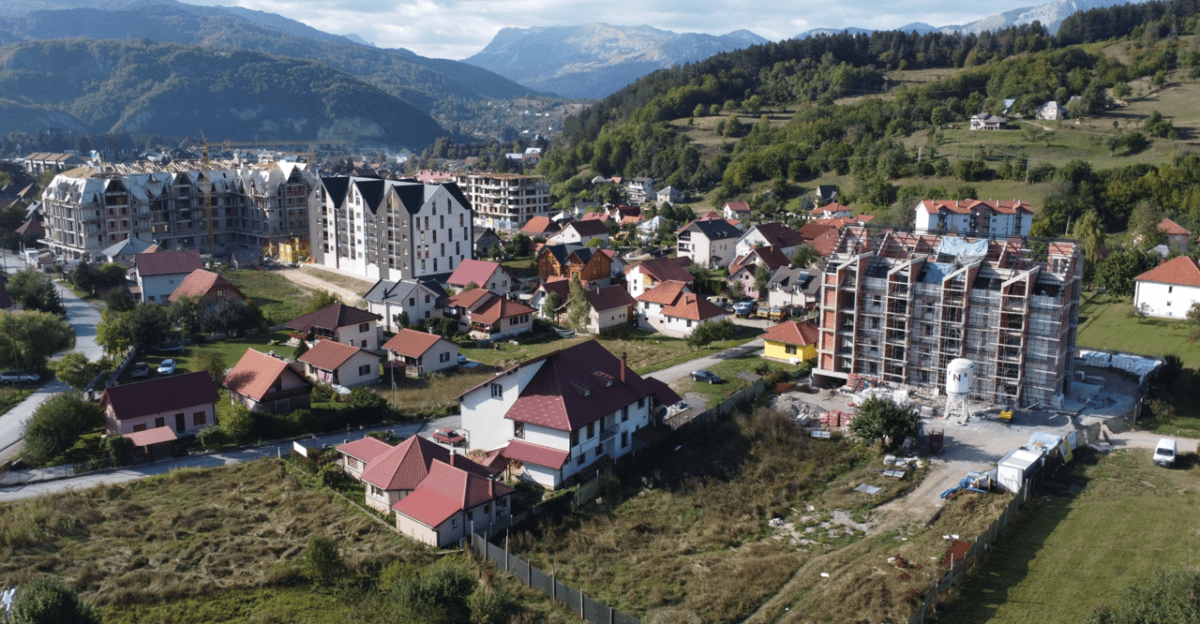Seemingly overnight, Kolašin has turned into a large construction site. After decades of aggressively promoted and poorly regulated real estate construction on the Montenegrin coast, which consumed the coastal space and its chances for sustainable future development, the same wave has reached Kolašin. Here, in this town of about 3,000 in the mountains of northern Montenegro, the preparations for a construction boom beyond the maximum limits of spatial and infrastructure capacities have been underway for a while. Even though most of Kolašin’s citizens are surprised by the new contours and heights in their urban surroundings, spatial planning documentation reveals that these conditions simply reflect the realization of ideas at least 15 years in the making. At the heart of these ideas is not an urban development vision that would foster the town’s economy and support local communities, but rather a scheme to extract wealth from its stunning landscape: to enable the maximization of profits for owners of investment capital and land suitable for construction. In short, neoliberal urbanism came to town and swiftly turned Kolašin into another case study for how market-driven policies of spatial development work against social equity, environmental sustainability, and local community well-being.
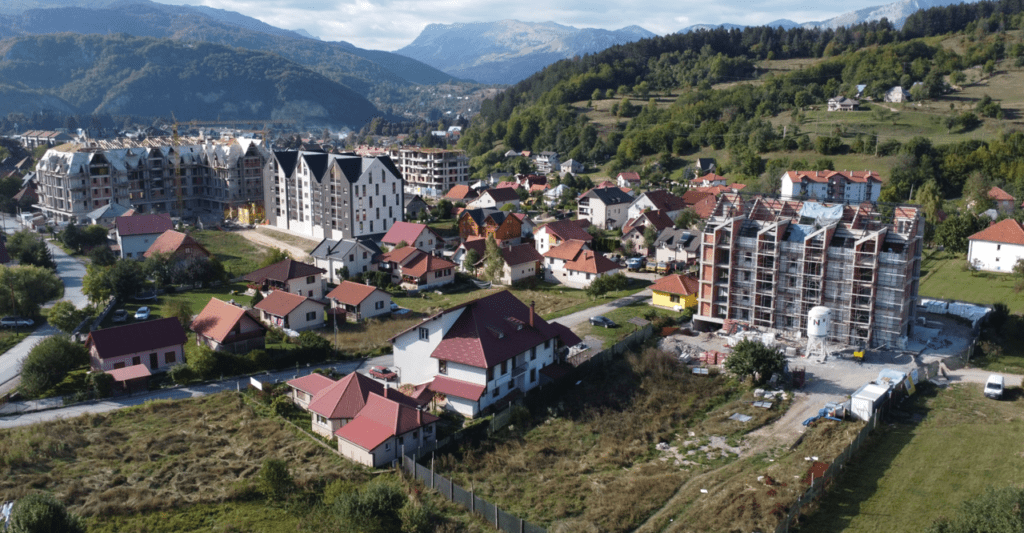
Outdated urban plans give rise to the new construction boom
The recent construction boom in Kolašin has been guided by urban plans dating back over a decade and adopted by the local government, which at the time justified the extensive planning for the new construction by the rising interest of tourists and the resulting need to build more accommodation units. The outline for expansions within the three central urbanized zones was presented in the detailed urban plans (DUP) for Kolašin-Center (2008), Smailagića Polje (2008), and Breza (2011). The DUP Kolašin-Center envisioned an increase in the city center’s built-up area by 7.5 times, from 115,000 m2 to 857,490 m2. Similarly, the DUPs for Smailagića Polje and Breza planned for increases of 22 and 28 times, respectively.1 Meanwhile, the demographic growth for the 2011-2020 period was projected at only 2% – hardly an increase that would demand this extent of new construction.2 Simply, the mushrooming of the new real estate was planned in order to support the lucrative business of developing private tourist accommodation.

By the time these plans were in place, tourism had already been strategically designated as the main branch of the Montenegrin economy. The government adopted the Strategy for the Development of Tourism in 2001, outlining rapid privatization and the creation of favorable conditions for direct foreign investments as the main policy priorities.3 The process of de-agrarianization of northern Montenegro, where Kolašin is situated, has been underway for decades, while local industry had been long gone by the late 2000s. The factories, once integrated with Yugoslavia’s larger wood, metal, and textile industries, had been privatized and foreclosed, leaving a large portion of the population without work or future job prospects. Formerly socially owned trade and tourism companies passed into the hands of local and state authorities eager to sell them off, following the postulates of Montenegro’s new, neoliberal economic system: open market economy, the dominance of private property, and the protection of private property rights. Attractive real estate was privatized hastily and at low prices.
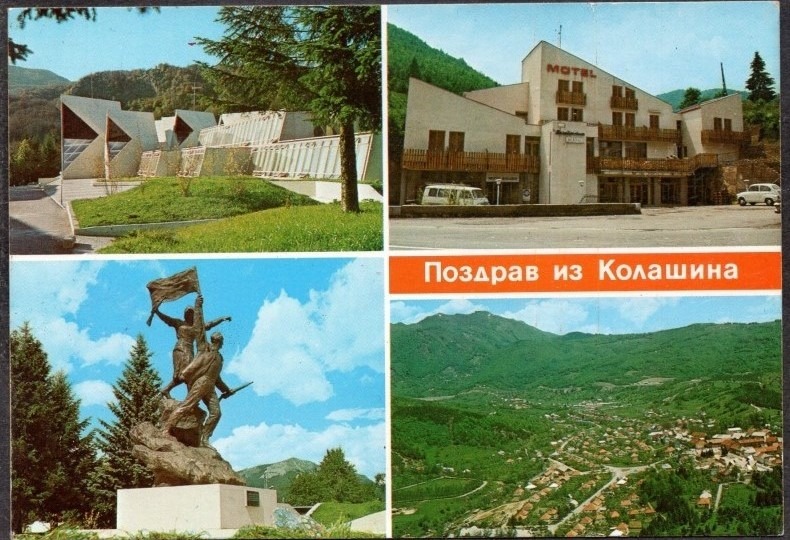
Kolašin tourism has a long history. The town was first established as a tourist location and an air spa4 during the 1930s. Therefore, the infrastructure and the skilled workforce already existed – but as other local industries were dismantled in the privatization process, hospitality and tourism were left as the main, if not only, branches of the new economy, and they required the development of the new private real estate. Just before the global economic crisis in the mid-2000s, the real estate market in Kolašin was booming – there was immense interest in buying land and in opportunities to build on it. The Kolašin municipality responded to this demand by adopting the detailed urban plans mentioned above for the town center, Smailagića Polje, and Breza and commissioning a series of local site studies for important peripheral locations. Then, the global economic crisis – triggered by real estate speculation on a global scale – disrupted both the world’s financial system and the exuberant plans for new construction in the mountains of Montenegro. Still, these planning documents remained in effect, allowing the old ideas to come to fruition now, regardless of their unsustainable and potentially dangerous character.
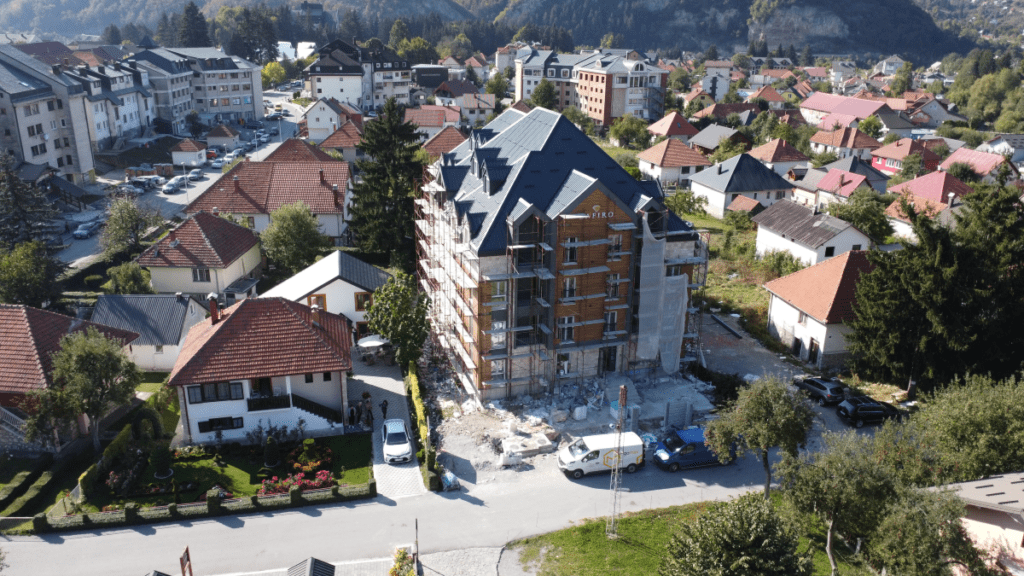
The ambitious construction plans for Kolašin’s central urban zone were assessed in the 2014 Spatial-urban Plan (PUP) of the Municipality of Kolašin, which was a strategic document and a higher-order plan developed under the Land Administration and Management Project. Through this project, the Ministry of Sustainable Development and Tourism and the World Bank sought to create planning documents for some of the smaller Montenegrin towns and simplify the process of issuing building permits. These measures were considered by these agencies crucial for the development of “a good business climate” in the country. The 2014 Spatial-urban Plan for the Municipality of Kolašin (PUP) criticized the existing plans, deemed the planned construction excessive, and advised that future planning should focus on designing public spaces and reconstructing significant buildings and public interest facilities. It also criticized the local site studies for allowing large-scale constructions in attractive yet inaccessible locations without adequate infrastructure, often disregarding higher-order plan restrictions.5 This analysis did not, however, affect changes to the existing plans. Despite the old plans’ shortcomings, they have remained in force to this day, providing the layout for the construction expansion we have witnessed in Kolašin over the past couple of years. This expansion is, therefore, unfolding according to proven low-quality, outdated plans that chart the excessive and unbalanced production of new private construction to the detriment of public spaces and amenities and at the expense of future sustainable development.
Economic citizenship program: how state economic policy determines local spatial condition
Montenegro has seen such spatial planning and the persistence of relevant institutions in implementing poor plans at all costs (and even presenting this as a political and economic success) many times before. The closest examples are the seaside tourist hotspots, Budva and the Bay of Kotor. Kolašin is perhaps unique in that the execution of these plans is happening a decade and a half after they were adopted. The problem of outdated and inadequate spatial plans is prevalent in Montenegro due to a myriad of political, legal, and technical issues.6 What is now happening in Kolašin is another example of how poor planning legislation and lack of regulation serve the short-term interests of capital while inhibiting an adequate response to the actual challenges of local spatial development, such as poor infrastructure and lack of public services.
The Kolašin construction boom, once brought to a halt due to the economic crisis of 2008, recently gained new momentum with the completion of part of the Bar-Boljare highway, which has improved the town’s connection with Podgorica and the south of Montenegro since mid-2022. The highway project, developed as part of the “Belt and Road” initiative, was steeped in controversy and described as one of the world’s most expensive roads, whose $1 billion cost caused severe debt problems for the Montenegrin government. It has also resulted in major environmental concerns. Nevertheless, it brought Kolašin and its ski slopes closer to the more affluent southern region of the country. It made the town more marketable as the next big opportunity to invest in the construction of short-term rentals and other forms of tourism and hospitality-focused real estate. While, as we have seen, the spatial plans favoring this kind of development were already in place, the sudden interest of investors in building and owning properties in Kolašin was sparked first and foremost by the economic citizenship program launched by the Government of Montenegro at the end of 2018.
In essence, the economic citizenship program was an efficient way to generate foreign demand for expensive real estate in northern Montenegro, benefiting investors who could build and market such properties. Specifically, this program offered foreign nationals the opportunity to acquire Montenegrin citizenship by investing in any of the “development projects” that the Government of Montenegro has approved, based on, among other things, the total amount of the investment and the number of new jobs expected to be created. Although these development projects could also pertain to agriculture and the processing industry, the government’s emphasis is specifically on tourism, with expected investments of at least 15,000,000 euros in the coastal region or the Capital City of Podgorica and at least 5,000,000 euros in the northern or central region of Montenegro. The final List of Development Projects includes only one project in agriculture and 12 in tourism. In most cases, developers behind these projects are local investors or companies that have long been active in the construction and real estate business in Montenegro. Once a project is accepted into the economic citizenship program, its investors gain access to a very appealing market segment: to acquire a Montenegrin passport, foreign nationals must invest at least 450,000 euros for projects in Podgorica or the coastal region of Montenegro, or 250,000 euros for projects in the northern or central region of Montenegro. Evidently, Montenegrin citizenship is considerably cheaper when purchased in the north of the country, and this circumstance has had a profound impact on the sudden construction boom in Kolašin.
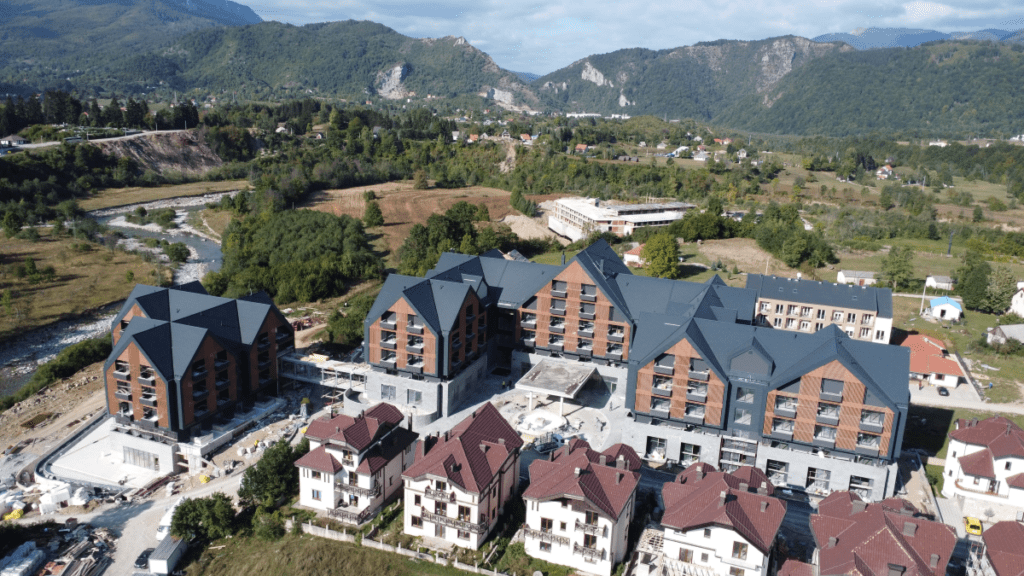
More than half (seven) of the twelve hotels on the List of Development Projects for the economic citizenship program are located in Kolašin, and each one of them plans to operate on a condo model. The condo hotel model in Montenegro involves selling residential units to private owners, who can use them personally but must also rent them out. Owners are required to rent their properties for ten months per year, with the option of using them for the remaining two months.7 Investment opportunities, therefore, include purchasing an apartment in a condo hotel for personal use, resale, or rental income generation. Put simply, those who wish to acquire Montenegrin citizenship in this manner do not actually have to engage in the development of the investment project – it’s enough to buy an apartment that is already under construction and, by doing so, support local investors in their business endeavors. On one side, we have foreign nationals who can meet the requirement for obtaining Montenegrin citizenship by purchasing an apartment in a Kolašin condo hotel for 250,000 euros; on the other side, we have domestic investors building the hotels and eager to sell their units at inflated prices. In the middle, we have the Government of Montenegro, promoting the economic citizenship program as a means of raising funds to “support” the less developed municipalities in the north of Montenegro.8 In reality, in this kind of “development,” the primary beneficiaries are the investors who profit from the program’s introduction of a new market and the excellent sale prices it sets for the condo units currently under construction. As of August 2022, the amount of funds collected for underdeveloped regions was 66.1 million euros, while investors received 190.5 million euros from the program.
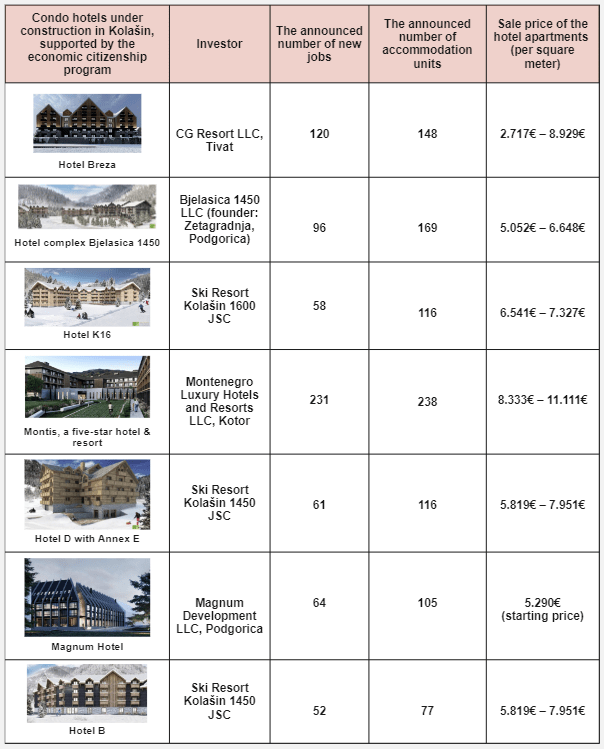
The investors acknowledge the benefits this program offers them. Some of their statements reveal that they will not need to enter into any credit obligations to realize the project in Kolašin. In other words, they can finance the investment with their own funds and expect significant revenue from selling hotel units. The provisions of the economic citizenship program clearly set the minimum prices of apartments in the new condo hotels, as demonstrated in their promotional materials. For example, in the “Kolašin 1450” hotel complex currently under construction at the “Kolašin 1450” Ski Resort, an apartment measuring 31.44 m2 costs 250,000 euros (precisely the amount required by the economic citizenship program), which amounts to 7,951 euros per square meter. Table 1 displays the sale prices of apartments in condo hotels that are part of the economic citizenship program and are currently under construction in Kolašin.9 According to this data, prices range from 2,717 to 11,111 euros per square meter, clearly showing the influence of the economic citizenship program on these prices and the artificially created demand for these properties over its three-year duration.
Luxury condos on top of poor public infrastructure
The economic citizenship program, whose moral, political, and security justifications have been questioned since its inception, was terminated at the end of 2022 upon the recommendation of the European Commission. However, the long-term impact of this program on Kolašin’s development will likely be challenging, especially with regard to the town’s inadequate public utility infrastructure. The deficiency in essential services such as water supply and sewage systems is apparent in the conceptual designs for new buildings. These designs often highlight the absence of necessary infrastructure, indicating their reliance on future developments planned by the local authorities, which are not likely to materialize in a timely manner. Official government reports come to similar conclusions: in January 2023, it was reported that the continuation of the construction of the “Bjelasica 1450″ hotel complex is jeopardized by the lack of infrastructural prerequisites, namely “connections to the electrical grid, water supply infrastructure, and sewerage system, as well as the lack of an access road.”
Kolašin’s current planning documents have long acknowledged the poor quality of the town’s public infrastructure, but the issue has never been addressed. As of 2023, only 8.5% of apartments are connected to the public sewage system, a marginal increase from 6% in 2003. Despite promised improvements and some ongoing work, it’s uncertain when and with what funding the city will address these extensive infrastructural needs. Until last year, the fee for providing communal utilities in Kolašin was notably low at 30 euros per square meter,10 with legal provisions allowing further reductions.11 The local government has decided to completely exempt some projects from paying for these communal utilities, justified by the argument that the investor is able to build better infrastructure than the municipality would. This has, of course, led to reduced municipal revenues, which are insufficient for current, let alone future, infrastructural demands. The scale of this challenge is evident when comparing the existing 226 hotel units in 2019 to the 969 units currently under construction in condo hotels (Table 1). If the required infrastructure is not developed, these new structures – which are, in fact, megastructures with respect to Kolašin’s limited spatial and infrastructural capacities – risk becoming non-functional and uninhabitable.
Even if this scenario does not come true, the “development” planned and implemented in this way is still profoundly problematic. Those who advocate for it highlight the employment opportunities these projects will supposedly create (Table 1). Yet, it remains unclear who exactly will be employed and what the quality of the new jobs will be, including whether these are seasonal and occasional jobs or permanent positions. Assuming that at least a portion of the new workforce for high-category hotels will have to come from outside (simply due to a lack of qualified personnel at the local level), the question arises as to where the new workers in Kolašin’s tourism industry will be able to live. A severe lack of affordable housing in Kolašin arises because “development” projects focus on building luxury accommodation units, with prices artificially inflated through public policies such as the economic citizenship program. The result is a sharp increase in prices for all real estate, which remains permanently out of reach for the working portion of the population unable to afford housing at these prices and in these conditions. It is, of course, the same result of the neoliberal production of urban space we have seen all over the world, leading to rising inequalities, displacement of working people, and theme park-like cities that seem to exist only to facilitate the highest possible rent extraction for the real estate owners.
Green Kolašin: articulating an alternative
All aspects of urban life and all city functions suffer when the sole aim of spatial planning is to enable private investors to maximize their profits by amassing new real estate. The citizens of Kolašin, both present and future, face a profit-oriented urban transformation in which shared resources and spaces, public and green areas, and architectural heritage are sacrificed while the functioning of the existing public infrastructure is jeopardized. In this process, Kolašinci are not gaining better living and working conditions, improved common spaces, or public policies. Instead, they are merely being convinced by the decision-makers and owners of capital that this rapid, aggressive, and long-term consumption of urban (and, until now, semi-urban and rural) space is the only path to development. While this is certainly not true, this message is amplified through official statements praising Kolašin as “the biggest construction site in northern Montenegro” and celebrating the arrival of the international hotel chains, and also at public discussions on new planning documents, where satisfying the investors’ and landowners’ wishes is proclaimed to be the ultimate goal of the spatial planning processes. Numerous private media outlets support and promote this narrative. Some have gone so far as to attack and defame a local journalist who dares to write critically on the subject.
The preparation of new planning documents for the Municipality of Kolašin is underway, with the new Spatial-Urban Plan (PUP) and Detailed Urban Plan (DUP) for the town center expected to be adopted in 2024. The current course of these processes does not indicate that there will be a significant shift in the spatial development policy, which continues to focus on the overdevelopment of tourist accommodation and neglects other urban needs and functions. Even when the plans foresee investments in public infrastructure and other projects of public importance, their realization is either put on hold or comparably slower than the construction of private projects. The new planning documents do not re-examine previously proposed solutions and miss the opportunity to adapt them to the new social, economic, environmental, and climate conditions. Compared to a decade ago, Kolašin’s tourist economy now encounters an entirely new set of challenges, especially with regard to climate change and environmental preservation. For example, Kolašin saw its first significant snowfall in 2023 on January 15th and in 2024 on January 20th – quite late in the skiing season, which underlined how feeble the local tourist economy can be when faced with a mild winter. Nevertheless, the planning solutions for Kolašin’s future remain the same. Outdated and inadequate, they make the town dangerously dependent on the erratic tourism and real estate industries and more vulnerable to economic, social, and spatial crises.
Under these circumstances, dissenting voices are starting to emerge as well. Since the beginning of 2023, the local initiative “Zeleni Kolašin” (“Green Kolašin”) has been working to articulate a different approach to the town’s future. A small group of activists has launched the campaign to challenge the dominant perspective and advocate for a gradual and sustainable urban development program that would prioritize the local community’s interests. The initiative’s focus is two-fold: clarifying the short-term and long-term spatial, economic, ecological, and social effects that spatial development policies in Kolašin have had, and influencing these policies through available forms of civic participation.
In December 2023, the initiative published a book, “Let’s Imagine Green Kolašin: An Engaged Response to the Construction Boom,” which outlines the group’s activities and chronicles their attempts to engage with the decision-makers. These include information campaigns, community meetings, petitions, policy recommendations, and analysis of how architectural designs for the new buildings fail to comply with the existing building regulations. The initiative’s survey of townspeople shows that 79.4% of respondents are not familiar with how decisions on spatial and urban planning are made, 96.9% have never participated in making such decisions, and only 2.5% are completely satisfied with how the town is currently developing. Obviously, local people are aware of the problems, which are only worsened by the aggressive new construction. However, this awareness is yet to be converted into a bolder and more consequential political action. Reasons for this can be found in the town’s recent history: for the last 30 years, Kolašin has been grappling with the loss of industry, lack of employment opportunities, and population decline. It has been described as a “town with no future.” The same could be said for the entirety of northern Montenegro, a former industrial region completely left behind during the neoliberal restructuring of the Montenegrin economy. Now that a sudden construction boom offers any kind of renewed relevance, however damaging it might be in the long run, how can Kolašin say no? It takes a lot of collective resolve, effort, and organizing to critically evaluate a long-awaited change while that change is afoot, which is why the emergence of “Green Kolašin” is important. It is also why, while it has gained some local support and national visibility, the initiative has not yet been able to substantially alter any local urban development policies it aims to change. The decision-makers refuse to acknowledge the apparent downsides of their plans and programs, while the political pressure from below is still not strong enough to jeopardize their positions.
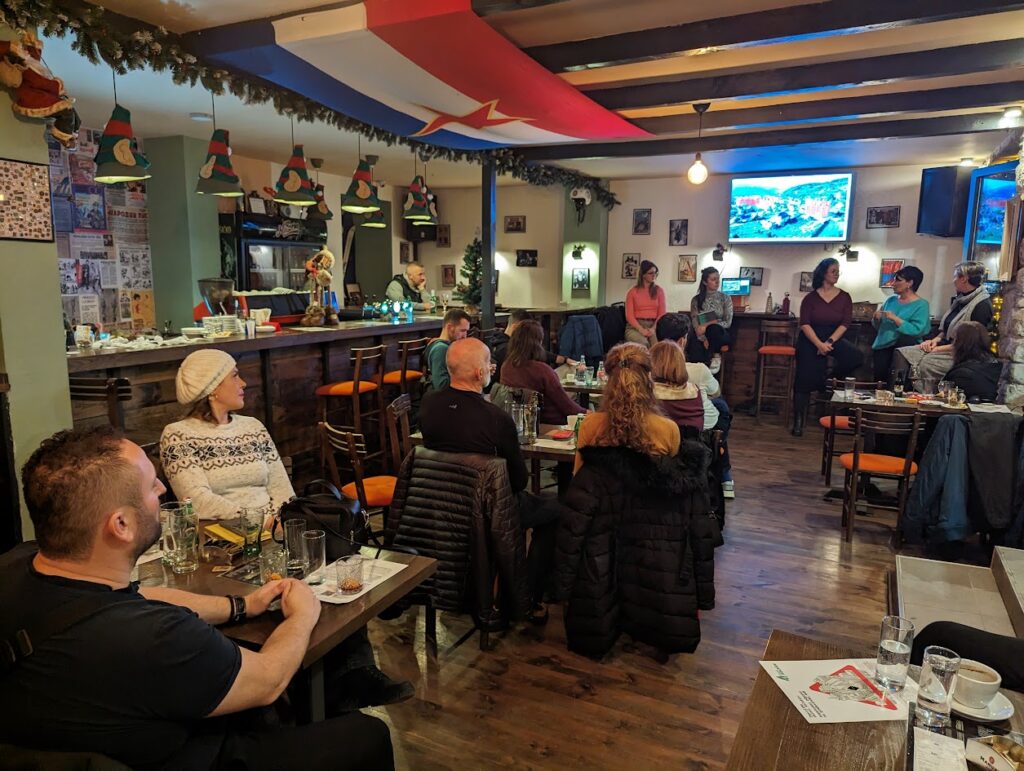
It is vital to understand that the construction boom in Kolašin is neither a coincidence nor an anomaly but an expected (and, for privileged owners of building land and investment capital, welcome) result of public policies that encourage expansive construction regardless of long-term social, economic, and ecological consequences. Kolašin’s case is an example of what happens when urban development policy prioritizes private interests, as it is required and conditioned to do under globalized neoliberal capitalism. At the core of these policies is privatization, which is both the primary instrument of the neoliberal economic order and its ultimate result: the privatization of spaces, resources, and decision-making processes to enable the acquisition of private wealth for the favored few. At the same time, the blame for economic hardship and political powerlessness is individualized. The dominant transitional narratives suggest that those left behind by the wave of (primitive) accumulation in the 1990s are to blame for their dispossession, including their failure to benefit from this form of spatial and economic “development.” That way, every criticism of the dispossession and privatization processes is rejected as a loser’s lament, while in reality, the entire society experiences a profound, systemic loss.
The case of Kolašin, therefore, is a warning. If nothing changes in how local and national public policies interpret and promote spatial development, this predatory scheme will continue to spread. It is high time for serious political work on designing and building different ways to manage local spaces and resources. We need alternative models aiming for spatial and economic justice, for creating common spaces, and improving public services. Green Kolašin and kindred initiatives from Montenegro and beyond continue to imagine, propose, and show what needs to be done – and continue to hope that the vital change in how we make and use our towns can be achieved while there’s still time and space for such change to materialize.
The Center for Investigative Journalism of Montenegro (CIN-CG) published an earlier version of this article in November 2023 as part of the publication titled “Public policies and private interests: how Kolašin turned into a construction site for the privileged.”

Sonja Dragović is a PhD researcher at the Center for Socioeconomic and Territorial Studies – DINÂMIA’CET-Iscte at the University Institute of Lisbon, where she is pursuing doctoral studies at the Department of Architecture and Urbanism as a scholarship holder of the Portuguese Foundation for Science, Research and Technology. Her interests include analyzing practices of urban activism and working with local communities toward improving participatory methods, public policies, and shared spaces. She is one of the editors of LeftEast and a member of activist and research collectives KANA/ko ako ne arhitekt and Biciklo.me (Podgorica) and Laboratório de Estudos Urbanos (Lisbon). She’s also a member of the Green Kolašin initiative.
Footnotes
- Spatial-urban plan for the Municipality of Kolašin (2014), p. 28
- Ibid, p. 98
- Agenda of economic reforms in Montenegro, 2002-2007
- According to publicist Branislav Jeknić, the local Society for Tourism, Foreign Traffic, and Beautification of the Town was established in the 1930s. In 1938, it promoted Kolašin as an ideal destination for summer vacations: “…A pleasant place for rest. A significant part of Montenegrin tourist life is concentrated in it and its surroundings. As an air spa and sanatorium, it has long been known and enjoys the reputation of being one of our country’s most beautiful summer resorts.” The term “air spa” (“vazdušna banja”) is used to describe a place which has exceptional air quality and is, therefore, suitable for rest, recovery, and sports trainings and tournaments
- Spatial-urban plan for the Municipality of Kolašin (2014), p. 29
- See Dragović, S. (2021), “The Volatile Policy Framework of Spatial Planning in Montenegro: Will the Centre Hold?” in “Governing Territorial Development in the Western Balkans: Challenges and Prospects of Regional Cooperation,” pp. 131-151
- Law on Tourism and Hospitality, Article 95, Official Gazette of the Republic of Montenegro, no. 2/2018, 4/2018. – corrected, 13/2018, 25/2019, 67/2019 – other law and 76/2020
- Article 10 of the “Decision on the criteria, method, and procedure for selecting individuals who can acquire Montenegrin citizenship through admission for the implementation of a special investment program of particular importance for the economic and business interest of Montenegro” states that one of the conditions that the applicant must fulfill is a payment of 100,000.00 euros for the development of underdeveloped municipalities
- Sales catalogs and websites used as sources of information for the sales prices: https://immigrantinvest.com/real-estate/montenegro/apartments-in-the-5-star-breza-hotel-en/, https://bjelasica1450.me/, https://k16resort.com/, https://immigrantinvest.com/real-estate/montenegro/apartments-in-a-five-star-hotel-in-the-montis-mountain-resort-en/, https://development.kolasin1450.com/, https://sothebysrealty.me/crown-plaza-hotel-residences-kolasin/
- The Kolašin Municipal Assembly only made a decision in March 2023 to increase this fee to 150 euros for construction in the first construction zone, 100 euros in the second, 70 euros in the third, and 30 euros in the fourth construction zone.
- For example, each of these hotels announces the creation of dozens of jobs; for buildings that provide new employment of more than 10 people, the amount of compensation for communal equipping of the land can be significantly reduced or waivered entirely.

